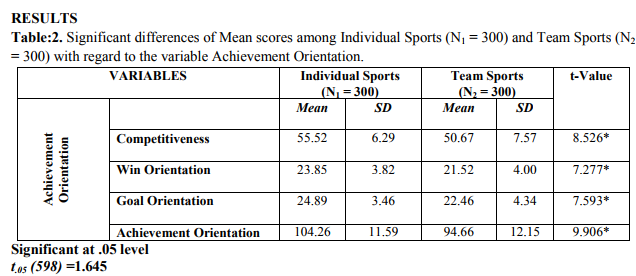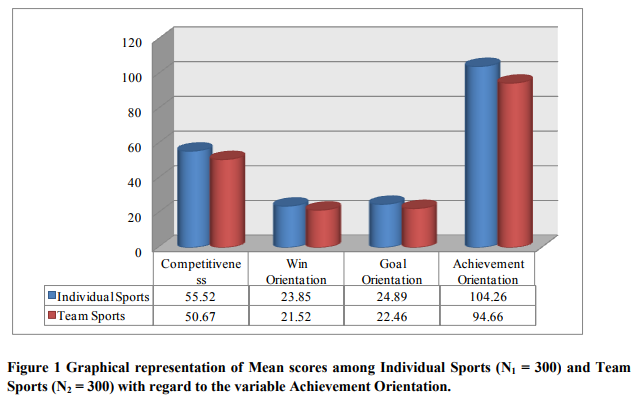IJCRR - 4(12), June, 2012
Pages: 208-212
Date of Publication: 22-Jun-2012
Print Article
Download XML Download PDF
ACHIEVEMENT ORIENTATION AMONG UNIVERSITY LEVEL INDIVIDUAL AND TEAM ATHLETES
Author: Amandeep Singh, Gurmeet Singh
Category: General Sciences
Abstract:The aim of the present study was to determine achievement orientation (competitiveness, win orientation
and goal orientation) among university level individual and team athletes. For this purpose, six hundred
(N=600) male athletes (individual sports N1 = 300 and team sports N2 = 300) of age ranging from 18 to 25 years were selected as subjects from various colleges affiliated to Guru Nanak Dev University, mritsar, Panjab University, Chandigarh and Punjabi University, Patiala. Sport Orientation Questionnaire (SOQ) developed by Gill and Deeter (1988), was used for collection of the data. The Student's t-test for
independent data was applied to find out the significance of differences among individual and team
athletes. The level of significance was set at 0.05. Results revealed significant between group differences
among individual and team athletes on the variable achievement orientation. While comparing the mean
values, it has been observed that the individual sports athletes have demonstrated significantly better than the team sports athletes on the variable achievement orientation. Considering the various parameters as applied on different set of subjects the results proved to be variant in nature and scope in relation to achievement orientation.
Keywords: Achievement Orientation, Individual Sports, Team Sports.
Full Text:
INTRODUCTION
The socio-psychological dynamics of an individual and team athletes are important components of sports psychology that emerged as a distinct scientific discipline, a specialization within the psychology. To analyze and explain the competitive behaviour of an individual or team athletes, we must understand and interpret their socio-psychological dimensions in movement context. Achievement Orientation is defined as the need to perform well or the striving for success. Atkinson(1964,1974) quote ?General achievement motivation is widely recognized as a capacity to experience pride in accomplishment or a disposition to strive for success across varied achievement situations and standards.‘ Achievement Orientation is a multidimensional psychological constraint which measures the individual differences in sport achievement orientation. In the present study, a psychological tool i.e. ?Sport Orientation Questionnaire‘ (SOQ) developed by Gill and Deeter (1988) to measure the achievement orientation by considering the dimensions; competitiveness, win and goal orientations was used.. Untiring efforts are being made in sports to create new records, to achieve new heights and to set new standards of excellence, which becomes possible not only taking into consideration the physical factors but socio – psychological factors as well. The variable under investigation i.e. achievement orientation may play an important role in achieving the desired goals. Therefore the purpose of the present study was to find out the significant differences between individual and team sports athletes with regard to the variable achievement orientation.
MATERIAL AND METHODS
Subjects:
A sample of six hundred (N = 600) male athletes, which includes three hundred (N1=300) individual sports (i.e. athletics, weightlifting, judo, boxing and swimming) and three hundred (N2=300) team sports (i.e. volleyball, basketball, football, handball and kabaddi) athletes, ranging between 18 to 25 years of age, was selected. The purposive sampling technique was used for the selection of the subjects. The samples were taken from the colleges affiliated to Panjab University, Chandigarh, Guru Nanak Dev University, Amritsar and Punjabi University, Patiala.

Tool used: Sport Orientation Questionnaire (SOQ) developed by Gill and Deeter, 1988, was used as a tool for data collection.
Methodology:
Achievement orientation among university level individual and team athletes was determined by administering Sport Orientation Questionnaire (Gill and Deeter, 1988), which is a multidimensional, sport specific measure of individual differences in sport achievement orientation. Three subscales of sports achievement orientation i.e. competitiveness, win orientation and goal orientation were taken into consideration which consists of thirteen, six and six items respectively. Each item is scored from 1 to 5 (i.e. A=5, B=4, C=3. D=2, E=1). The subjects were instructed to read each statement carefully and encircle the letter that indicates how much you agree or disagree with each statement on the scale: A, B, C, D, and E.
Statistical analysis:
The Statistical Package for the Social Sciences (SPSS) version 16.0 was used for all the analyses. The Student‘s t-test for independent data was applied to find out the significance of differences among individual and team athletes. The level of significance was set at 0.05.

The results of achievement orientation among university level individual and team athletes are presented in table-2. Table exhibited the mean values of individual and team athletes on competitiveness as 55.52 (±6.29) and 50.67 (±7.57), on win orientation 23.28 (±3.82) and 21.52 (±4.00) and on goal orientation 24.89 (±3.46) and 22.46 (±4.34) respectively. Analysis of data revealed, significant between-group differences were found for all the three subscales of achievement orientation i.e. competitiveness (t=8.5259*), win orientation (t=7.2769*) and goal orientation (t=7.5927*). Table also showed the mean values of individual and team athletes on Achievement Orientation as 104.26 (±11.59) and 94.66 (±12.15) and?t‘ 9.9061*, since the computed value of ?t‘ for all the dimensions were greater than the tabulated t.05 (598) =1.645. Thus it may be concluded that Achievement Orientation found to be statistically significant. The graphical representation of responses has been exhibited in Fig. 1.

DISCUSSION
The purpose of this study was to determine the significant difference of achievement orientation among university level individual and team athletes. Analysis of data revealed that significant between-group differences were found for all the three subscales of achievement orientation i.e. competitiveness (t=8.5259*), win orientation (t=7.2769*) and goal orientation (t=7.5927*). While comparing the means, individual sports athletes have exhibited higher mean values on all the three subscales (i.e. competitiveness, win orientation and goal orientation) of the variable achievement orientation. Considering the various parameters as applied on different set of subjects the results proved to be variant in nature and scope in relation to achievement orientation. Hayashi (1996) conducted a study on Hawaiian male weightlifters and their Anglo-American counterparts. It was observed that Hawaiians identified the weight-room environment, and individual differences in achievement goals, through an interdependence-based orientation. These results are similar to the present study. Ryska and Yin (1999) suggested that athletes' perceptions of situational rather than dispositional aspects of achievement goals are more highly affected by the playing structure present in youth sport teams. These affects are also observed in the present study. Results of the present study are not in lines with the study conducted by Singh (1999). He worked on inter-college level 476 subjects of individual and team game athletes. Individual and team game athletes showed sameness on all three variables of achievement orientation. There were no significant differences among athletes belonging to different sport groups in competitiveness, win orientation and goal orientation.
CONCLUSION
It is concluded from the above findings that significant between group differences were found among individual and team athletes on the variable achievement orientation. Significant between-group differences were also found for all the three subscales of achievement orientation i.e. competitiveness, win orientation and goal orientation. While comparing the mean values, it has been observed that the individual sports athletes have demonstrated significantly better than the team sports athletes on the variable achievement orientation. Individual sports athletes have exhibited higher mean values as compared to the team sports athletes on all the three subscales (i.e. competitiveness, win orientation and goal orientation) of the variable achievement orientation.
ACKNOWLEDGEMENTS
Authors acknowledge the immense help received from the scholars whose articles are cited and included in references of this manuscript. The authors are also grateful to authors / editors / publishers of all those articles, journals and books from where the literature for this article has been reviewed and discussed. Authors would like to thank departments of Physical Education, of concerned colleges affiliated to Guru Nanak Dev University, Amritsar, Panjab University, Chandigarh and Punjabi University, Patiala for providing assistance in collecting the relevant information for undertaking quality research.
References:
1. Atkinson, J.W. (1964). An Introduction to Motivation. Princeton, NJ: Van Nostrand.
2. Atkinson, J.W. (1974). The Main Springs of Achievement-Oriented Activity. In J.W. Atkinson and J.O Raynor (Eds.), Motivation an Achievement. New York: Halstead.13- 41.
3. Gill, D.L. and Deeter, T.E. (1988). Development of the Sports Orientation Questionnaire. Research Quarterly for Exercise and Sports, 59(3), 191-202.
4. Hayashi, Carl T. (1996). Achievement Motivation among Anglo-American and Hawaiian Male Physical Activity Participants: Individual Differences and Social Contextual Factors. Journal of Sport and Exercise Psychology. Human Kinetics Publishers, Inc.
5. Ryska, T.A. and Yin, Z. (1999). Dispositional and Situational Goal Orientations as Discriminators among Recreational and Competitive League Athletes. The Journal of Social Psychology, 139(3), 335-342.
6. Singh, Karamjit. (1999). A Study of SocioPsychological Characteristics of University Level Individual and Team Athletes. Unpublished Ph.D. Thesis, Faculty of Education (Physical Education), Panjab University, Chandigarh.
|






 This work is licensed under a Creative Commons Attribution-NonCommercial 4.0 International License
This work is licensed under a Creative Commons Attribution-NonCommercial 4.0 International License